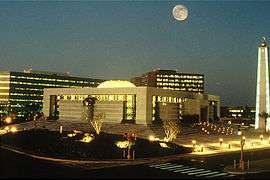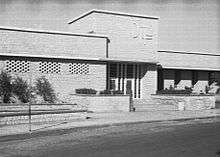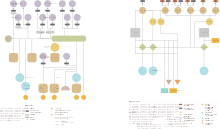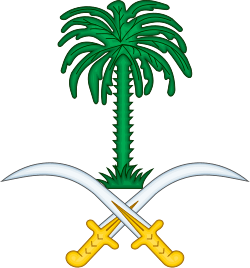Saudi Aramco
 | |
 Headquarters in Dhahran, Saudi Arabia | |
| State-owned enterprise | |
| Industry | Oil and gas |
| Founded |
1933 (as California-Arabian Standard Oil Company) 1944 (as Arabian-American Oil Company) 1988 (as Saudi Arabian Oil Company/Saudi Aramco) |
| Headquarters | Dhahran, Saudi Arabia |
Area served | Worldwide |
Key people |
Amin H. Nasser, President & CEO Khalid A. Al-Falih, Chairman & Minister of Energy, Industry and Mineral Resources |
| Products | Petroleum, natural gas and other petrochemicals |
| Revenue | Confidential |
|
| |
| Owner | Government of Saudi Arabia (100%) |
Number of employees | 65,266 (2016)[2] |
| Website |
www |
Saudi Aramco (Arabic: أرامكو السعودية ʾArāmkō s-Saʿūdiyyah), officially the Saudi Arabian Oil Company, (formerly Arabian-American Oil Company), is a Saudi Arabian national petroleum and natural gas company based in Dhahran.[3][4]
It is one of the largest companies in the world by revenue, and according to accounts seen by Bloomberg News, the most profitable company in the world.[5] Saudi Aramco has both the world's second-largest proven crude oil reserves, at more than 270 billion barrels (4.3×1010 m3),[6] and second-largest daily oil production.[7]
Saudi Aramco's financial data were leaked in April 2018 and according to Bloomberg's analysts the company could be valued at $1.2 trillion, significantly lower than the official figure of $2 trillion backed by Saudi officials.[8]
Headquartered in Dhahran, Saudi Arabia,[9] Saudi Aramco operates the world's largest single hydrocarbon network, the Master Gas System. Its 2013 crude oil production total was 3.4 billion barrels (540,000,000 m3), and it manages over one hundred oil and gas fields in Saudi Arabia, including 288.4 trillion standard cubic feet (scf) of natural gas reserves. Saudi Aramco operates the Ghawar Field, the world's largest onshore oil field, and the Safaniya Field, the world's largest offshore oil field.[10]
History
Saudi Aramco's origins trace to the oil shortages of World War I and the exclusion of American companies from Mesopotamia by the United Kingdom and France under the San Remo Petroleum Agreement of 1920.[11] The US administration at the time had popular support for an "Open Door policy", which Herbert Hoover, secretary of commerce, initiated in 1921. Standard Oil of California (SoCal) was among those US companies seeking new sources of oil from abroad.[12]
Through its subsidiary company, the Bahrain Petroleum Co. (BAPCO), SoCal struck oil in Bahrain in May 1932. This event heightened interest in the oil prospects of the Arabian mainland. On 29 May 1933, the Saudi Arabian government granted a concession to SoCal in preference to a rival bid from the Iraq Petroleum Co.[13] The concession allowed SoCal to explore for oil in Saudi Arabia. SoCal assigned this concession to a wholly owned subsidiary, California-Arabian Standard Oil (CASOC). In 1936, with the company having had no success at locating oil, the Texas Oil Co. (Texaco) purchased a 50% stake of the concession.[14] After four years of fruitless exploration, the first success came with the seventh drill site in Dhahran in 1938, a well referred to as Dammam No. 7.[15] This well immediately produced over 1,500 barrels per day (240 m3/d), giving the company confidence to continue. On 31 January 1944 the company name was changed from California-Arabian Standard Oil Co. to Arabian American Oil Co. (or Aramco).[16] In 1948, Standard Oil of New Jersey (later known as Exxon) purchased 30% and Socony Vacuum (later Mobil) purchased 10% of the company, with SoCal and Texaco retaining 30% each.[17] The newcomers were also shareholders in the Iraq Petroleum Co. and had to get the restrictions of the Red Line Agreement lifted in order to be free to enter into this arrangement.[18]

In 1950, King Abdulaziz threatened to nationalize his country's oil facilities, thus pressuring Aramco to agree to share profits 50/50.[19]
A similar process had taken place with American oil companies in Venezuela a few years earlier. The American government granted US Aramco member companies a tax break known as the golden gimmick equivalent to the profits given to King Abdulaziz. In the wake of the new arrangement, the company's headquarters were moved from New York to Dhahran.[20] In 1951, the company discovered the Safaniya Oil Field, the world's largest offshore field. In 1957, the discovery of smaller connected oil fields confirmed the Ghawar Field as the world's largest onshore field.[10]
In 1975, the Saudi Arabia second five-year economic plan included a Master Gas Plan. Natural gas would be used to generate power, rather than flaring the gas. The plan counted on using the associated gas, but by 1985, Aramco was able to include a billion standard cubic foot per day (Bscfd) of non-associated gas. This non-associated gas was produced from the Kuff Formation, which is a limestone 650 m below the oil producing Arab Zone. In 1994, Aramco discovered more non-associated gas in the deeper Jawf sandstone formation, and built plants in Hawiyah and Haradh to process it. This increased the capacity of the Master Gas System to 9.4 billion scfd.[21]:98-100,104,129-130,229
In 1973, following US support for Israel during the Yom Kippur War, the Saudi Arabian government acquired a 25% "participation interest" in Aramco's assets. It increased its participation interest to 60% in 1974 and acquired the remaining 40% interest in 1976. Aramco continued to operate and manage the former Aramco assets, including its concessionary interest in certain Saudi Arab oil fields, on behalf of the Saudi Arab Government until 1988. In November 1988, a royal decree created a new Saudi Arab company, the Saudi Arabian Oil Company, to take control of the former Aramco assets (or Saudi Aramco)[22] and took the management and operations control of Saudi Arabia's oil and gas fields from Aramco and its partners. In 1989–90, high-quality oil and gas was discovered in three areas south of Riyadh: the Raghib area about 77 miles southeast of the capital.[23]
In Sept. 1990, after the start of the Gulf War, Aramco was expected to replace much of the oil production removed from the global market due to the embargo of Iraq and occupied Kuwait. This amounted to producing an extra 4.8 million barrels per day (Mbpd) to keep the global oil market stable. In addition, Aramco was expected to provide all of the coalition aviation and diesel needs. Aramco recommissioned 146 Harmaliyah, Khurais, and Ghawar oil wells with associated gas oil separation plants, and saltwater treatment pipeline, that had been mothballed during the 1980s oil price collapse. Daily production increased from 5.4 Mbpd in July to 8.5 Mbpd in Dec. 1990 after a three month de-mothball effort.[21].:125,135,148-149,155-156
Starting in 1990, Aramco embarked on an expansion of crude oil sales in the Asian market. Agreements with Korea, the Philippines, and China resulted. By 2016, about 70% of Aramco's crude oil sales were to Asia.[21]:168,176,184-185
In May 2001, Saudi Arabia announced the Gas Initiative, which proposed forming 3 joint ventures with 8 IOCs for gas exploration on pure upstream acreage. Core Venture 1 included south Ghawar and north Rub' Al-Khali, Core Venture 2 included the Red Sea, while Core Venture 3 involved Shaybah and Kidan. In 2003, Royal Dutch Shell and Total S.A. formed a partnership with Saudi Aramco in Core Venture 3. In 2004, Core Venture 1 became three separate joint ventures with Saudi Aramco holding 20%, one with Lukoil, a second with Sinopec, and a third with Repsol.[21]:228-232
By 2004, Aramco was producing 8.6 million barrels per day (mbpd) out of a potential 10 mbpd. In 2005, Aramco launched a five year plan to spend $50 billion to increase their daily capacity to 12.5 mbpd by increasing production and refining capacity and doubling the number of drilling rigs.[21]:241-242
In 2005, Saudi Aramco was the world's largest company with an estimated market value of $781 billion.[24]
In June 2008, in response to crude oil prices exceeding $130 a barrel, Aramco announced it would increase production to 9.7 million barrels per day (mbpd). Then as prices plummeted, Aramco stated in Jan. 2009, that it would reduce production to 7.7 mbpd.[21]:265-267
In 2011, Saudi Aramco started production from the Karan Gas Field, with an output of more than 400 million scf per day.[25]
In January 2016, the Deputy Crown Prince of Saudi Arabia, Mohammad bin Salman Al Saud, announced he was considering listing shares of the state-owned company, and selling around 5% of them in order to build a large sovereign fund.[26]
Wall Street Journal reported in September 2018, Aramco was considering a $1 billion venture-capital fund to invest in international technology firms.[27]
2012 cyber attack
Aramco computers were attacked by a virus on 15 August 2012.[28][29] The following day Aramco announced that none of the infected computers were part of the network directly tied to oil production, and that the company would soon resume full operations.[30] Hackers claimed responsibility for the spread of the computer virus.[31] The virus hit companies within the oil and energy sectors.[32][33] A group named "Cutting Sword of Justice" claimed responsibility for an attack on 30,000 Saudi Aramco workstations, causing the company to spend a week restoring their services.[28] The group later indicated that the Shamoon virus had been used in the attack.[34] Due to this attack, the main site of Aramco went down and a message came to the home page apologizing to customers.[35] Computer security specialists said that "The attack, known as Shamoon, is said to have hit 'at least one organization' in the sector. Shamoon is capable of wiping files and rendering several computers on a network unusable."[33] Richard Clarke suggests the attack was part of Iran's retaliation for the U.S. involvement in Stuxnet.[36]
Operation


Saudi Aramco is headquartered in Dhahran, but its operations span the globe and include exploration, production, refining, chemicals, distribution and marketing. All these activities of the company are monitored by the Saudi Arabian Ministry of Petroleum and Mineral Resources together with the Supreme Council for Petroleum and Minerals.[37] However, the ministry has much more responsibility in this regard than the council.[37]
Exploration
A significant portion of the Saudi Aramco workforce consists of geophysicists and geologists. Saudi Aramco has been exploring for oil and gas reservoirs since 1982. Most of this process takes place at the Exploration and Petroleum Engineering Center (EXPEC). Originally, Saudi Aramco used Cray Supercomputers (CRAY-1M) in its EXPEC Computer Center (ECC)[38] to assist in processing the colossal quantity of data obtained during exploration and in 2001, ECC decided to use Linux clusters as a replacement for the decommissioned Cray systems. ECC installed a new supercomputing system in late 2009 with a disk storage capacity of 1,050 terabytes (i.e, exceeding one petabyte), the largest storage installation in Saudi Aramco's history to support its exploration in the frontier areas and the Red Sea.[39]
Refining and chemicals
While the company did not originally plan on refining oil, the Saudi government wished to have only one company dealing with oil production. Therefore, on 1 July 1993, the government issued a royal decree merging Saudi Aramco with Samarec, the country's oil refining company. The following year, a Saudi Aramco subsidiary acquired a 40% equity interest in Petron Corporation, the largest crude oil refiner and marketer in the Philippines. Since then, Saudi Aramco has taken on the responsibility of refining oil and distributing it in the country.[10] In 2008, Saudi Aramco sold its entire stake to the Ashmore Group, a London-listed investment group. Ashmore acquired an additional 11% when it made a required tender offer to other shareholders. By July 2008, Ashmore, through its SEA Refinery Holdings B.V., had a 50.57 percent of Petron's stock. Ashmore's payment was made on December 2008. In December 2008, Ashmore acquired PNOC's 40% stake. In the same month, San Miguel Corporation (SMC) said it was in the final stages of negotiations with the Ashmore Group to buy up to 50.1 percent of Petron. In 2010, SMC acquired majority control of Petron Corporation.
Currently, Saudi Aramco's refining capacity is 5.4 million barrels per day (860,000 m3/d) (International joint and equity ventures: 2,500 Mbbl/d (400,000,000 m3/d), domestic joint ventures: 1,900 mpbd, and wholly owned domestic operations: 1,000 Mbbl/d (160,000,000 m3/d).)[40]
Saudi Aramco's downstream operations are shifting emphasis to integrate refineries with petrochemical facilities. Their first venture into it is with Petro Rabigh, which is a joint venture with Sumitomo Chemical Co. that began in 2005 on the coast of the Red Sea.[10]
List of refineries
List of domestic refineries:[40]
- Jizan Refinery and terminal projects (JRTP) (4,00,000 bbl/d) (64,000 cubic meter/d) Jizan construction ongoing.
- Jeddah Refinery (78,000 bbl/d (12,400 m3/d)) Jeddah converted to product storage terminal in Nov. '17.
- Ras Tanura Refinery (550,000 bbl/d (87,000 m3/d)) (includes a Crude Distillation Unit, a Gas Condensate Unit, a hydrocracker, and catalytic reforming)
- Riyadh Refinery (126,000 bbl/d (20,000 m3/d))
- Yanbu Refinery (245,000 bbl/d (39,000 m3/d))
List of domestic refining ventures:[40]
- The Saudi Aramco Mobil Refinery Co. Ltd. (SAMREF), Yanbu (400,000 bbl/d (64,000 m3/d))
- The Saudi Aramco Shell Refinery Co. (SASREF), Jubail (300,000 bbl/d (48,000 m3/d))
- Petro Rabigh, Rabigh (400,000 bbl/d (64,000 m3/d))
- Saudi Aramco Base Oil Co. (Luberef)
- Saudi Aramco Total Refining and Petrochemical Co. (SATORP), Jubail[41] (400,000 bbl/d (64,000 m3/d))
- Yanbu Aramco Sinopec Refinery (YASREF), Yanbu (400,000 bbl/d (64,000 m3/d))
List of international refining ventures:[42]
- Fujian Refining and Petrochemical Co. (FRPC), People's Republic of China
- Sinopec SenMei (Fujian) Petroleum Co. Ltd. (SSPC), People's Republic of China
- Motiva Enterprises LLC, United States 1,070,000 bbl/d (170,000 m3/d)
- Showa Shell, Japan 445,000 bbl/d (70,700 m3/d)
- S-Oil, Republic of Korea 669,000 bbl/d (106,400 m3/d)
- Saudi Refining Inc., United States[43]
Shipping
Saudi Aramco has employed several tankers to ship crude oil, refined oil and gas to various countries. It has created a subsidiary company, Vela International Marine, to handle shipping to North America, Europe and Asia.[44] It is a stakeholder in the King Salman Global Maritime Industries Complex, a shipyard that will be the largest in the world when complete.[45]
Saudization
The original concession agreement included Article 23; as Ali Al-Naimi pointed out, this was a "key building block in the shaping of Saudi society for decades to come." It reads, "The enterprise under this contract shall be directed and supervised by Americans who shall employ Saudi nationals as far as practicable, and in so far as the company can find suitable Saudi employees it will not employ other nationals." The first company school was started in May 1940 in the Al-Khobar home of Hijji bin Jassim, company interpreter, translator and first instructor. Al-Naimi pointed out, "From the beginning, the development of Aramco was directly tied to the betterment of Saudi Arabia." Another school was located in Dhahran in 1941, and was called the Jebel School. Boys hired into entry level positions attended at 7 AM for four hours, followed by four hours of work in the afternoon. In 1950, Aramco built schools for 2400 students. In 1959, Aramco sent the first group of Saudi students to college in the States. In 1970, Aramco started hiring its first high school graduates, and in 1979 started offering college scholarships. In 1965, Zafer H. Husseini was named the first Saudi manager and in 1974, Faisal Al-Bassam was named the first Saudi vice president. One of the early students was Al-Naimi, who was named the first Saudi president of Aramco in Nov. 1983. As Al-Naimi states, "The oil company committed itself to developing qualified Saudis to become fully educated and trained industry professionals." Al-Naimi acknowledged Thomas Barger's championing of Saudization, "You, of all of Aramco's leaders, had the greatest vision when you supported the training effort of Saudi Arab employees during its early days. That visionary support and effort is bearing fruit now and many executive positions are filled by Saudis because of that effort." In 1943, 1600 Saudis were employed at Aramco, but by 1987, nearly two-thirds of Aramco's 43,500 strong workforce, were Saudis. In 1988, Al-Naimi became CEO and Hisham Nazer became chairman, the first Saudis to hold those positions. The "pinnacle of Saudization" occurred when the Shaybah oil field came on line in July 1998, after a three year effort by a team consisting of 90% Saudis. The Aramco of 2016 still maintained an expatriate workforce of about 15%, so Aramco can, in the words of Al-Naimi, "be sure it is getting access to the latest innovations and technical expertise."[21]
Environmental record
According to geographer Richard Heede,[46] Aramco has led the list of companies with the highest level of CO2 emissions globally since 1995 with a towering 1,707 million tonnes (1.680×109 long tons; 1.882×109 short tons) in 2013, amounting to almost 3.4% of worldwide anthropogenic emissions.[47]
The company allegedly covered up a large oil spill in 1993.[48]
See also
- Ghawar
- Max Steineke
- Shamoon
- List of oil fields: All of those located in Saudi Arabia are owned by Saudi Aramco.
- Abqaiq
- Aramco Financial Services Company
- Aramco Training Services Company
- Golden gimmick
- Thomas Barger
- Discovery! The Search for Arabian Oil
- Saudi Aramco Medical Services Organization
- Saudi Aramco Residential Camp in Dhahran
- List of corporations by market capitalization
- Shaybah
- Max Steineke
- Ras Tanura
- Yanbu
- Udhailiyah
- Hui-Hai Liu
References
- ↑ "The Aramco Accounts: Inside the World's Most Profitable Company".
- ↑ "Key facts and figures". Saudi Aramco. Archived from the original on 6 June 2017. Retrieved 28 April 2017.
- ↑ The Report: Saudi Arabia 2009. Oxford Business Group. 2009. p. 130. ISBN 978-1-907065-08-8.
- ↑ "Our company. At a glance". Saudi Aramco.
The Saudi Arabian Oil Co. (Saudi Aramco) is the state-owned oil company of the Kingdom of Saudi Arabia.
- ↑ "Aramco Accounts Show Saudi Oil Giant Is World's Most Profitable Company". Bloomberg.com. 2018-04-13. Retrieved 2018-04-13.
- ↑ OPEC, Annual Statistical Bulletin 2016
- ↑ "Production of Crude Oil including Lease Condensate 2016" (CVS download). U.S. Energy Information Administration. Retrieved 27 May 2017.
- ↑ "Saudi Aramco, By the Numbers". Bloomberg.com. Retrieved 2018-07-15.
- ↑ "Contact Us", Saudi Aramco. Retrieved 5 November 2009. "Headquarters: Dhahran, Saudi Arabia Address: Saudi Aramco P.O. Box 5000 Dhahran 31311 Saudi Arabia"
- 1 2 3 4 Aramco Overseas Company - About Saudi Aramco, aramcooverseas.com. Retrieved 11 November 2014.
- ↑ "Conference of San Remo". Encyclopædia Britannica. Retrieved 15 February 2015.
- ↑ Owen, E.W. (1975). Trek of the Oil Finders: A History of Exploration for Petroleum. Tulsa: AAPG. pp. 1290–93.
- ↑ Yergin, Daniel (2008). The Prize: The Epic Quest for Oil, Money and Power. New York: Simon and Schuster. pp. 265–74. ISBN 978-1439110126.
- ↑ "Oil Company Histories". Virginia University. Retrieved 9 August 2012.
- ↑ "Seven Wells Of Dammam". Saudi Aramco World.
- ↑ "Saudi Arabian Oil Company History from Fundinguniverse.com". Funding Universe. Retrieved 18 August 2012.
- ↑ "The Story of Oil in Saudi Arabia". Saudi Gazette. 18 May 2008. Archived from the original on 6 October 2014. Retrieved 2 October 2014.
- ↑ Morton, Michael Q. (2013). "Once Upon a Red Line: The Iraq Petroleum Company Story". GeoExpro (Ipad App 6). Retrieved 2 October 2014.
- ↑ "From Arab Nationalism to OPEC: Eisenhower, King Saʻūd, and the making of U.S-Saudi relations", Nathan J. Citino, Indian University Press, 2002, retrieved 28 February 2012
- ↑ "Saudi Aramco by the Numbers". Saudi Aramco World. 9 (3). May–June 2008. Retrieved 2 October 2014.
- 1 2 3 4 5 6 7 Al-Naimi, Ali (2016). Out of the Desert. Great Britain: Portfolio Penguin. pp. 14, 26–28, 50–51, 76, 93, 109–110, 119, 122–123, 129, 143, 222. ISBN 9780241279250.
- ↑ "Timeline". Saudi Embassy. Retrieved 25 June 2012.
- ↑ "Saudi Aramco Announces Oil and Gas Find, Third Since July". Associated Press. 7 January 1990. Retrieved 31 December 2012.
- ↑ "Financial Times Non-public Top 150". Financial Times. Retrieved 23 September 2012.
- ↑ DiPaola, Anthony (26 July 2011). "Saudi Aramco Starts Production From Karan Gas Field in July". Bloomberg.
- ↑ "Saudi Arabia is considering an IPO of Aramco, probably the world's most valuable company". The Economist. 7 January 2016. Retrieved 23 May 2016.
- ↑ Jones, Rory; Said, Summer (2018-09-06). "Aramco Weighs $1 Billion Venture Capital Fund For Tech". Wall Street Journal. ISSN 0099-9660. Retrieved 2018-09-07.
- 1 2 Perlroth, Nicole (24 October 2012). "Cyberattack On Saudi Firm Disquiets U.S.". The New York Times. p. A1.
- ↑ "Saudi Aramco says virus shuts down its computer network". 15 August 2012.
- ↑ "Aramco Says Virus Attacks Network, Oil Output Unaffected". 16 August 2012.
- ↑ Arthur, Charles (16 August 2012). "Saudi Aramco hit by computer virus". The Guardian.
- ↑ "Shamoon virus attacks Saudi oil company". Digital Journal. 18 August 2012. Retrieved 19 August 2012.
- 1 2 "Shamoon virus targets energy sector infrastructure". BBC News. 16 August 2012.
- ↑ "Virus knocks out computers at Qatari gas firm RasGas". CNET. 30 August 2012. Retrieved 1 September 2012.
- ↑ "Some Signs Point to Shamoon as Malware in Aramco Attack". Threat Post. 16 August 2012.
- ↑ in Zero Days, 1:43
- 1 2 "Saudi Arabia". Revenue Watch Institution. Retrieved 16 September 2013.
- ↑ Cray FAQ Part 3: FAQ kind of items Archived 21 August 2007 at the Wayback Machine., spikynorman.dsl.pipex.com. Retrieved 11 November 2014.
- ↑ "Saudi EXPEC Computer Center Deploys Supercomputer", 24 February 2010. Retrieved 11 November 2014.
- 1 2 3 "Saudi Aramco Annual Review 2015" (PDF). Retrieved 8 June 2017.
- ↑ "SAUDI ARAMCO TOTAL Refining and Petrochemical Co. (SATORP) completes US$8.5 Billion project financing for Jubail Refinery". Retrieved 18 August 2012.
- ↑ Saudi Aramco Annual Review 2010, saudiaramco.com. Retrieved 11 November 2014.
- ↑ Seba, Erwin (18 March 2016). "Exclusive: After Motiva split, Saudi Aramco aims to buy more U.S. refineries - sources". Reuters. Retrieved 25 January 2016.
- ↑ "History". Vela International Marine Limited. Retrieved 9 August 2012.
- ↑ "Bahri, Partners Step Closer to Set Up Maritime Yard in Saudi Arabia". World Maritime News. 1 June 2016. Retrieved 13 May 2017.
- ↑ "Rick Heede Biography". Climatemitigation.com. Retrieved 25 June 2017.
- ↑ Douglas Starr (25 August 2016). "Just 90 companies are to blame for most climate change, this 'carbon accountant' says". Science Magazine.
- ↑ "Was A MASSIVE Saudi Aramco Oil Spill Concealed From The Public In 1993?".
Bibliography
- Vitalis, Robert (2006). America's Kingdom: Mythmaking on the Saudi Oil Frontier. Stanford: Stanford University Press. ISBN 0-8047-5446-2.
External links
| Wikimedia Commons has media related to Saudi Aramco. |
- Web site of Aramco Services Co. - Saudi Aramco's US Subsidiary
- A CNN report about the security of oil in Saudi Arabia. Much of it is about Saudi Aramco security.
- Saudi Arabia's crude oil production chart (1980-2004) - Data sourced from the US Department of Energy
- CBS 60 Minutes (2008-12-07) "The Oil Kingdom: Part One".
- CBS 60 Minutes (2008-12-07) "The Oil Kingdom: Part Two".
